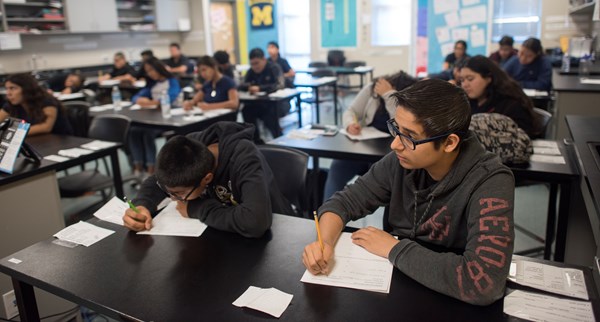Schools throughout Arizona are on track to receive Results Based Funding if the Governor’s Executive Budget is adopted as proposed.
Results Based Funding (RBF) incentivizes public schools – traditional district, magnet, and charter – to grow their impact and serve more students by awarding additional per-pupil funding to Arizona’s top-rated schools.
In 2018, 285 schools, with a total of about 145,000 students, benefitted from RBF. With Governor Ducey’s FY 19-20 Executive Budget, 675 schools are estimated to receive the funding in FY 2020 under expanded eligibility requirements.
The Western School of Science and Technology (WSST), located in the Maryvale community of West Phoenix, was founded in 2014 and would be eligible to receive RBF for the first time under the plan outlined in the Executive Budget.
WSST serves grades 7-12 and is determined to reach an ‘A’ rating so it can provide the many underserved students in the area with the tools they need to gain a postsecondary education and reach their goals.
Peter Boyle, WSST founding school director, explained that every student of the school’s first graduating class graduated on time and had a postsecondary plan.
If WSST receives RBF, Boyle explained it will be used to “to accelerate our student success by ensuring that we’re investing in our teachers’ development and the tools they need in the classroom to be successful.”
As WSST may receive RBF for the first time this year, Alhambra Traditional School (ATS) benefitted from the funding last year and has used it to make a variety of improvements.
ATS is an ‘A’ rated school that was founded in 1983 and focuses on strong academics in an effort to successfully prepare its students for high school.
“One of the key things that makes us successful is that our teachers are very highly experienced. They’re willing to do whatever it takes to help students achieve and be successful,” Richard Stinnett, ATS principal, said.
ATS applied the RBF it received last year to focus on its teachers and continuously improve the learning environment for its students.
“There’s an allowance that can be used for teacher salaries, to hire teachers, to provide professional development. So, in working with the district and in working with the school team, the decision was made to largely allocate the money to teachers,” Stinnett said.
ATS recently moved to a new campus and is now able to welcome more students, staff and programs.
“We’ve had more families that have come into ATS this year that are new than at any time before. We added three new teachers last year and we have another teacher to be added this year,” Stinnett explained.
In the past year that ATS has received RBF, it also increased from 93 percent to 98.83 percent on the state grading scale.
Stinnett explained that additional resources allow the school to better retain its high-performing teachers, which ultimately benefits ATS students of various backgrounds.
“One thing about ATS is we don’t have an achievement gap among our subgroups, meaning that whatever background, ethnicity, demographics of students that we have here, they are all successful and they are all making great strides,” Stinnett said.
He added, “There’s always the question of, ‘How are you doing with all of your kids?’ and we’re doing very well and we’re proud of that and it’s something we can advertise to other potential families.”
According to the Executive Budget, a school’s letter grade and Free and Reduced Lunch (FRL) percentage will determine its qualification for RBF. The following will determine a school’s eligibility:
- 60% or greater FRL $400 per pupil for A-grade schools
- 60% or greater FRL $225 per pupil for B-grade schools
- Less than 60% FRL $225 per pupil for A-grade schools
















Add comment